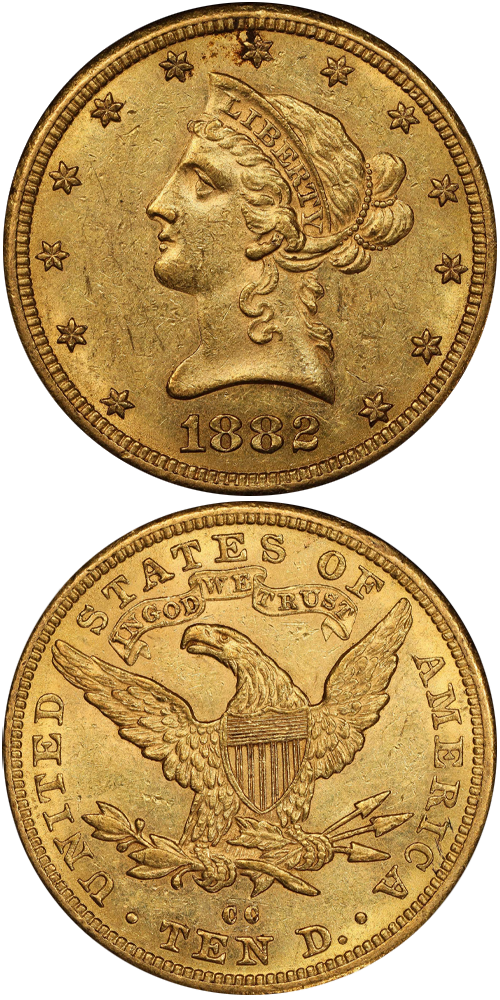1882-CC Liberty Head Eagle
Jeff Ambio: Both of the known varieties of the 1882-CC eagle share the same reverse, with the CC mintmark tall and evenly spaced. The first C is above the right edge of the letter E in TEN and the second C is centered over the letter N in the same word. On the obverse of the Winter 1 variety, the date is a bit low in the field and slants down slightly from left to right. This is a misplaced date variety with faint remnants of two 8s in the denticles below and slightly to the right of the primary 8s in the date.
Rusty Goe: In a year in which allegations against the Carson City Mint's superintendent, James Crawford, would place that man's integrity under a magnifying glass, that institution staged a magnificent comeback. Ever since 1878, the Carson Mint's productivity had declined. The Treasury Department had suspended coining operations at different points in all three of those years. However, by the end of June, at annual cleanup and settlement time, the Carson Mint had not missed one month of work in 1882. Even appropriations for another year of operations, into 1883, came without the usual resistance.
Prospects at the local coin factory looked bright for the first time in a long while. Then, in July, a new newspaper in town, the Daily Bee, began to buzz about insinuations aimed at Superintendent Crawford, purportedly by disgruntled former employees of the mint. The Treasury Department dispatched Mint Director Burchard to Nevada to investigate, and later a special agent, Frederick Eckfeldt, of the prominent family of minters, arrived in Carson City to preside over a hearing. After returning to Washington, DC, and presenting his findings to Burchard and other Treasury officers, deliberations began.
The Appeal of November 9, 1882, wrote "that the charges made against [the mint] officials have been crushed under the weight of sworn evidence." In September, Coiner Dague had delivered 6,764 gold eagles, the only examples of that denomination he struck in 1882. For some reason, the 1882-CC eagle shows a disproportionately high extant population figure, perhaps four percent of the original output. Still, Mint State examples are extremely rare.
Q. David Bowers: Of the 1882-CC eagles struck, Rusty Goe estimates 240 to 280 in all grades, with two to four Uncirculated. My estimate is 125 to 175 overall with one or two in Mint State. VF and EF are typical grades seen in the marketplace. In his 1988 Encyclopedia Walter Breen noted that this issue is "prohibitively rare above EF." No doubt most if not all 1882-CC eagles originally circulated stateside, with some later going overseas in bulk shipments -- by which time the coins already had wear.
In his May 1914 sale of the William F. Gable Collection S. Hudson Chapman offered Lot 235, an extraordinary coin: "1882-CC. Uncirculated. Mint luster. Two very faint scratches in field before neck. Rare. 6,754 struck." How this would be graded today is anyone's guess, and no doubt the scratches would play a part.
The example to the left was sold by Stack's Bowers Galleries in the Fairmont Collection, Hendricks Set, where it realized $36,000.






